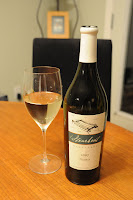As you might have gathered from our little Odyssey thus far, I don't tend to drink a lot of American wine. It's not that I don't like it. It's just that I find the tax structure up here in BC does its very best to increase the price of wines in general - and imports in particular - and, when you combine that with a normally strong US dollar, there's just not a lot of incentive to buy US wines. The ones that I tend to see up here are either pretty generic or they cost an arm and a leg.
So, we try to take advantage of any chances that we get to try out and buy some wines whenever we venture South of the 49th parallel. Since I was heading down to Seattle for a big Saturday night shindig, I took off Friday afternoon so that I could fit in the 48 hours that I needed to spend in the States in order to be able to bring the whopping allocation of TWO whole bottles of wine tax-free.
As an alternative to spending both nights in Seattle, I joined up with my Dad at his and Mom's vacation trailer at Black Mountain Ranch by Mount Baker. I'm quite positive that I can count the number of times I've been there on the fingers of one hand, but it provided an opportunity to spend a bit of time with Dad and the chance to visit a Costco that actually sells wine. Crazy stuff for this Canadian boy.
After loading up on a case or so that I could leave at Mom & Dad's for their eventual repatriation to my place, Dad and I headed back to the trailer and cracked open the first bottle.
 337. 2006 Tamarack Cellars Syrah (Columbia Valley - Washington State)
337. 2006 Tamarack Cellars Syrah (Columbia Valley - Washington State)I was a little disappointed - not in the wine - but in the fact that I couldn't find out much about Tamarack Cellars. The same little snippet of information seems to show up on all the websites I happened upon. It's a family run winery that's been in existence since 1998 and it produces about 11,000 cases of wine from grapes sourced from varying Washington appellations in the Columbia Valley.
I don't know enough about the Washington designations but I believe Tamarack buys grapes from vineyards across about seven sub-appellations in the Columbia Valley - probably much like how BC's Okanagan Valley is starting to see individual areas like the Naramata Bench, Black Sage Road and Golden Mile appear and try to differentiate themselves. There was no individual designation on this bottle but a list of wines on the winery's website shows that they appear to produce wines that are more regionalized than just the Columbia Valley. Those wines likely don't make it to Costco.
I liked the Syrah though. I did see one reference that said the wine saw a 7% infusion of Cab Sauv, but the wine was certainly on the New World side of the stage - lots of upfront fruit and body. And someone else must like the wines because Tamarack's website prominently shows that it was voted 2009's Winery of the Year by Wine & Spirits magazine.
The bottle was $25 at Costco, but my guess is that it would hit you well over $40 if you could find it back in BC. Hopefully, I'll get some chance to pop some more American corks during this short stay - but Dad & I left it at one for this night.


















































